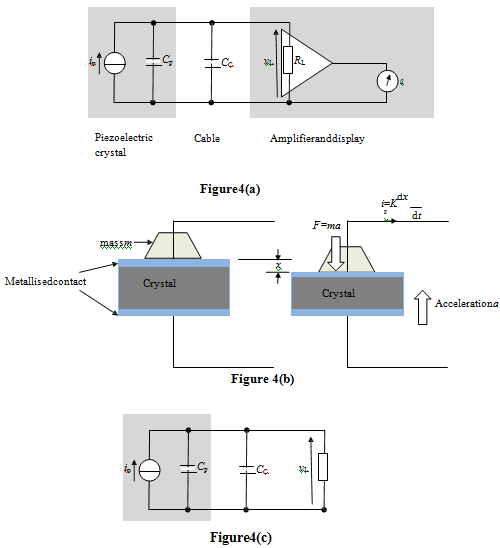Reference no: EM13826221
Part -1:
1. A FIGURE 1 shows a 50 ? load being fed from two voltage sources via their associated reactances. Determine the current i flowing in the load by:
(a) applying Thevenin's theorem
(b) applying the superposition theorem
(c) by transforming the two voltage sources and their associated reactances into current sources (and thus form a pair of Norton generators).
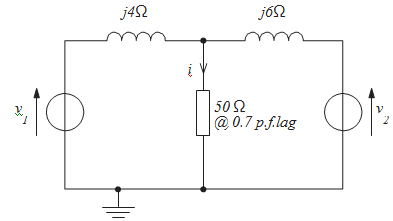
v1 = √2 x 415 cos(100Πt) volts
v2 = √2 x 415 cos(100Πt) volts
2. Determine, using the values given in TABLE A, the current I in the circuit of FIGURE 2 by:
(a) mesh analysis
(b) nodal analysis.
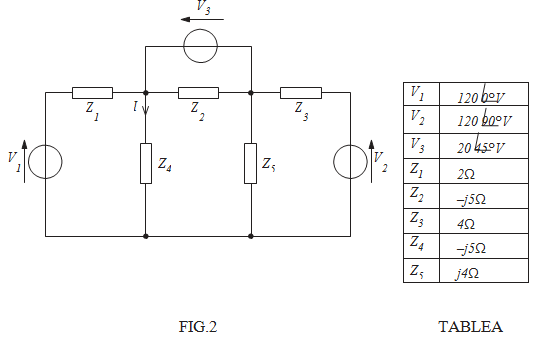
3. For the balanced three-phase loads shown in FIGURE 3, ZY = (15 + j15) ? and Z? = (45 + j45) ?. Determine:
(a) the equivalent single ?-connected load,
(b) the equivalent single Y-connected load obtained from the ?-Y transformation of (a) above,
(c) the equivalent single Y-connected load obtained by transforming the ? sub-load of FIGURE 3 to a Y and with the star-points of the two Y-sub-circuits connected together,
(d) the total power consumed in case (a) above if the line voltage of the three-phase supply is 415 V at 50 Hz.
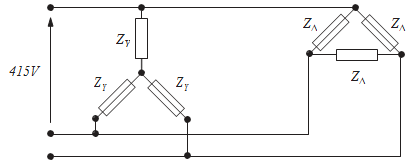
4. FIGURE 4(a) shows two inductances connected in parallel across an a.c. supply.
(a) Apply Kirchhoff's voltage law to loop abef and to loop abcdef of the circuit.
(b) Hence or otherwise obtain the current ratio I1/I2 circuit inductances.
(c) See if you can show that L1 and L2 can be replaced by the equivalent inductor, Leq, of FIGURE 4(b) where
Leq = L1L2 - M2/L1 + L2 -2M
(d) A 1 nF capacitor is placed across the two inductors (FIGURE 4 (c)). If L1 = L2 = L and k = 0.5, determine the required value of L if the minimum current I flows from the supply when it is at a frequency of 1 MHz.
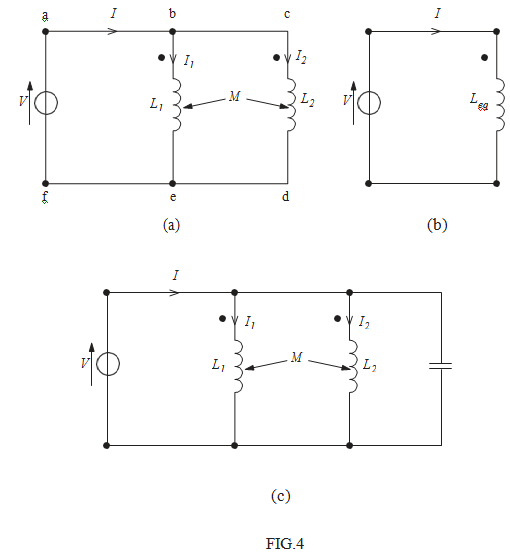
5. A 415V to 11 kV transformer has a rating of 200 kVA. The winding resistance and leakage reactance when referred to the primary are 0.014 ? and 0.057 ? respectively.
(a) Determine the % regulation of the transformer at 0.8 power factor lagging.
(b) In designing a particular 415V to 11 kV, 200 kVA transformer, the primary winding resistance is to be 10 m?. Find the maximum winding resistance of the secondary winding if the transformer is to have 2% regulation at unity power factor.
Part -2:
1. Find the z-parameters of the two-port 8 ? network given in FIGURE 1. 1 2
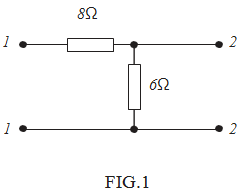
2. (a) A transmission line has a length, l, of 0.4λ. Determine the phase change, βl, that occurs down the line.
(b) A 50 ? lossless transmission line of length 0.4λ is terminated in a load of (40 + j30) ?. Determine, using the equation given below, the input impedance to the line.
Zin = Z0 ZLcosβl + jZ0sinβl/Z0cosβl + jZLsinβl
3. (a) State what is meant by a ‘distortionless' and a ‘lossless' transmission line.
(b) A transmission line has the primary coefficients as given in TABLE A. Determine the line's secondary coefficients Zo, α and β at a frequency of 1 GHz.
|
R
|
2?/m
|
|
L
|
8 nH/m
|
|
G
|
0.5mS/m
|
|
C
|
0.23pF/m
|
4. Calculate the insertion loss of the T-network of FIGURE 2, given the values in the table. (Use equation (6) of Lesson 3.) The transmission matrix for the T- network is:

5. FIGURE 5(a) represents a 50 Hz, high-voltage, transmission line. The relationships between the sending and receiving end voltages and currents are given by the complex ABCD equations:
Vs = VR(A1 + jA2) + IR (B1+ jB2)
Is = VR(C1 + jC2) + IR (D1+ jD2)
where the subscripts ‘S' and ‘R' are for the sending-end and receiving- end respectively.
(a) Given the parameter values in TABLE C and an open-circuit received voltage measured as 88.9 kV, calculate the values of VS and IS and hence the power (PSO) absorbed from the supply by the transmission line on open circuit.
(b) If the line is modelled by the T-circuit of FIGURE 3(b), see if you can estimate the primary line coefficients R, L, G and C. The line is 50 km long.
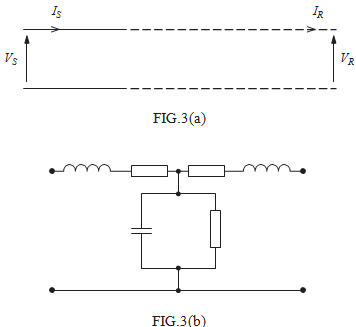
|
A1
|
0.8698
|
|
A2
|
0.03542
|
|
B1
|
47.94?
|
|
B2
|
180.8?
|
|
C1
|
0 S
|
|
C2
|
0.001349 S
|
|
D1
|
0.8698
|
|
D2
|
0.03542
|
Part -3:
1. a) In relation to Fourier analysis state the meaning and significance of
i) odd and even functions
ii) half-wave symmetry {i.e. f(t+π)= -f(t)}.
Illustrate each answer with a suitable waveform sketch.
b) State by inspection (i.e. without performing any formal analysis) all you can about each of the periodic waveforms shown in FIGURE 1 in terms of their Fourier series when analysed about t = 0.
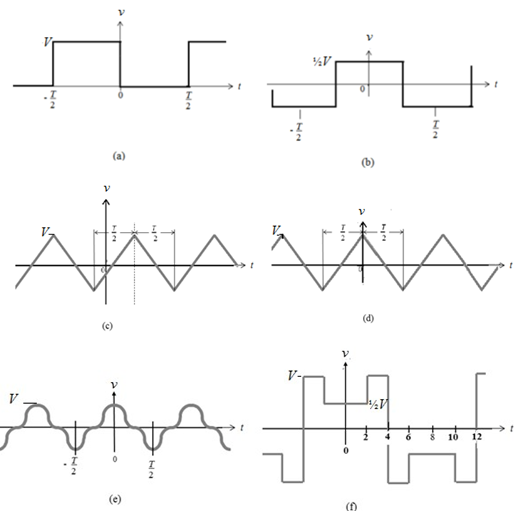
Question 2:
a) If the firing angle is set for α = Π/3 estimate the power dissipated in the bulb if it is rated at 100 W and the voltage source is 230 V @ 50 Hz.
b) An anomaly that can occur in controlled rectification is drift of the firing angle on one half cycle, so causing an asymmetrical waveform, as illustrated opposite. State the effect, if any, this would have on the harmonic content of the waveform.
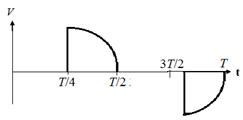
c) Sketch the waveform defined below and explain how you would obtain its Fourier series:
f (ωt) = 0 for 0 ≤ ωt ≤ Π/2
f (ωt) = Vsin(ωt) for Π/2 ≤ ωt ≤ Π
f (ωt) = 0 for Π ≤ ωt ≤ 3Π/2
f (ωt) = Vsin(ωt) for 3Π/2 ≤ ωt ≤ 2Π
Develop the analysis as far as you are able.
Question 3
i) Obtain the Fourier Transform for the data using the Fourier Analysis tool of Excel. The transformed data should commence in cell D2.
ii) Identify the principal frequencies in the current waveform.
iii) Estimate the total harmonic distortion [THD] present in the current waveform using the formula:
THD(1) = 1/I1√n=2∑max(In)2 x100%
where I1 is the r.m.s. value of the fundamental current, In the r.m.s value of the nth harmonic and n(max) is the number of the highest measurable or significant harmonic.
iv) Attempt to synthesise the shape of the original waveform from its principal harmonics [e.g. sketch the waveforms of the harmonics on the same time axis and add them together].
Q4. Sketch, on a set of common axes, waveforms to represent the transient response of circuits having transfer functions with the following parameters:
a) ς = 0.5, ωo = 1 x 103 rad s-1 b
b) ς = 0.2, ωo = 2 x 103 rad s-1 c
c) ς = 2, ωo = 1 x 103 rad s-1 b
Q5 a) With the aid of a table of standard transforms, determine the Laplace
Transform of:
a) 10 + 3t2 + sin4t
b) 4e-3t sin2t
b) With the aid of a table of standard transforms, determine the Inverse Laplace Transform of:
a) 5/s2, 12/s-4
b) 3s + 9/ (s+3)2 +7
Question 6:
a) Draw the Laplace form of the input portion of the circuit, as represented in FIGURE 4(c).
b) Derive an expression for the Laplace transfer function, T(s) = ΔvL/Δis(s), of the circuit of FIGURE 4(c).
c) Express ΔvL as a function of time (i.e. the transient response of the voltage ΔvL when ip is subject to a step change.
d) Using the values given in TABLE A, estimate the time taken for the voltage vL to reach its steady state value if the current ip is subject to a step change of 2 nA.
|
CP
|
1400pF
|
|
CC
|
250pF
|
|
RL
|
5MW
|
